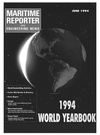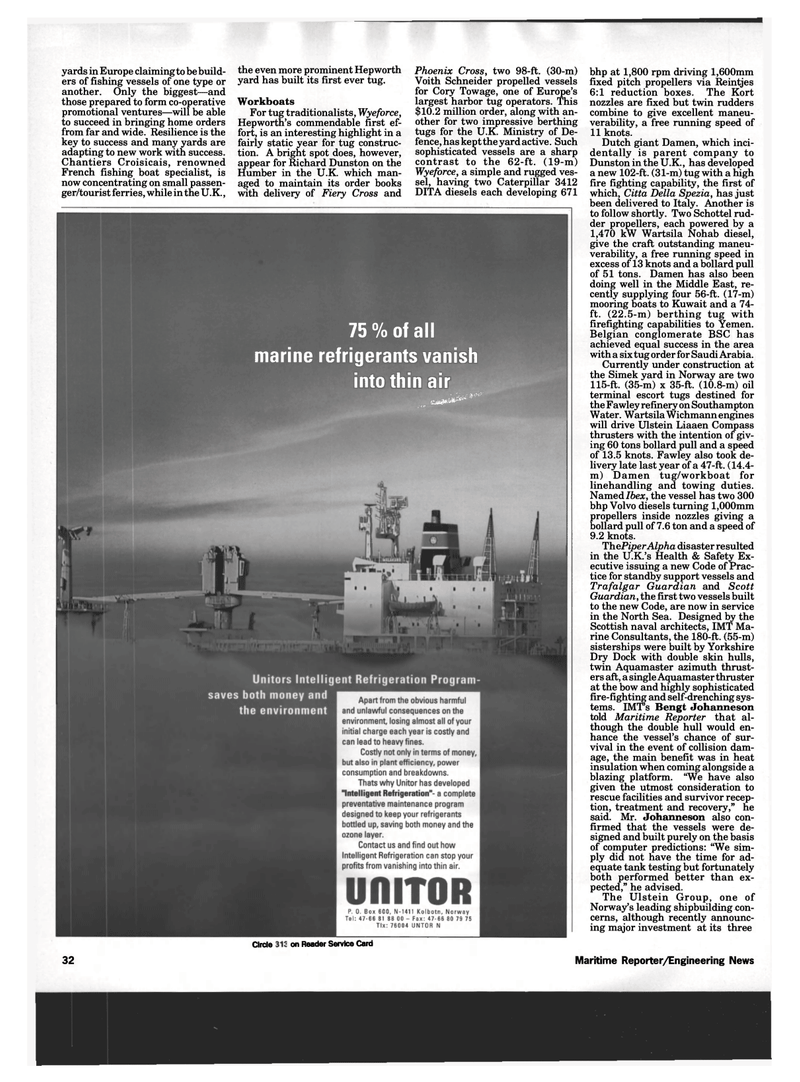
Page 26: of Maritime Reporter Magazine (June 1994)
Read this page in Pdf, Flash or Html5 edition of June 1994 Maritime Reporter Magazine
yards in Europe claiming to be build- ers of fishing vessels of one type or another. Only the biggest—and those prepared to form co-operative promotional ventures—will be able to succeed in bringing home orders from far and wide. Resilience is the key to success and many yards are adapting to new work with success.
Chantiers Croisicais, renowned
French fishing boat specialist, is now concentrating on small passen- ger/tourist ferries, while in the U.K., the even more prominent Hepworth yard has built its first ever tug.
Workboats
For tug traditionalists, Wye force,
Hepworth's commendable first ef- fort, is an interesting highlight in a fairly static year for tug construc- tion. A bright spot does, however, appear for Richard Dunston on the
Humber in the U.K. which man- aged to maintain its order books with delivery of Fiery Cross and
Phoenix Cross, two 98-ft. (30-m)
Voith Schneider propelled vessels for Cory Towage, one of Europe's largest harbor tug operators. This $10.2 million order, along with an- other for two impressive berthing tugs for the U.K. Ministry of De- fence, has kept the yard active. Such sophisticated vessels are a sharp contrast to the 62-ft. (19-m)
Wye force, a simple and rugged ves- sel, having two Caterpillar 3412
DITA diesels each developing 671 bhp at 1,800 rpm driving 1,600mm fixed pitch propellers via Reintjes 6:1 reduction boxes. The Kort nozzles are fixed but twin rudders combine to give excellent maneu- verability, a free running speed of 11 knots.
Dutch giant Damen, which inci- dentally is parent company to
Dunston in the U.K., has developed a new 102-ft. (31-m) tug with a high fire fighting capability, the first of which, Citta Delia Spezia, has just been delivered to Italy. Another is to follow shortly. Two Schottel rud- der propellers, each powered by a 1,470 kW Wartsila Nohab diesel, give the craft outstanding maneu- verability, a free running speed in excess of 13 knots and a bollard pull of 51 tons. Damen has also been doing well in the Middle East, re- cently supplying four 56-ft. (17-m) mooring boats to Kuwait and a 74- ft. (22.5-m) berthing tug with firefighting capabilities to Yemen.
Belgian conglomerate BSC has achieved equal success in the area with a six tug order for Saudi Arabia.
Currently under construction at the Simek yard in Norway are two 115-ft. (35-m) x 35-ft. (10.8-m) oil terminal escort tugs destined for the Fawley refinery on Southampton
Water. Wartsila Wichmann engines will drive Ulstein Liaaen Compass thrusters with the intention of giv- ing 60 tons bollard pull and a speed of 13.5 knots. Fawley also took de- livery late last year of a 47-ft. (14.4- m) Damen tug/workboat for linehandling and towing duties.
Named Ibex, the vessel has two 300 bhp Volvo diesels turning 1,000mm propellers inside nozzles giving a bollard pull of 7.6 ton and a speed of 9.2 knots.
ThePiper Alpha disaster resulted in the UK's Health & Safety Ex- ecutive issuing a new Code of Prac- tice for standby support vessels and
Trafalgar Guardian and Scott
Guardian, the first two vessels built to the new Code, are now in service in the North Sea. Designed by the
Scottish naval architects, IMT Ma- rine Consultants, the 180-ft. (55-m) sisterships were built by Yorkshire
Dry Dock with double skin hulls, twin Aquamaster azimuth thrust- ers aft, a single Aquamaster thruster at the bow and highly sophisticated fire-fighting and self-drenching sys- tems. IMT's Bengt Johanneson told Maritime Reporter that al- though the double hull would en- hance the vessel's chance of sur- vival in the event of collision dam- age, the main benefit was in heat insulation when coming alongside a blazing platform. "We have also given the utmost consideration to rescue facilities and survivor recep- tion, treatment and recovery," he said. Mr. Johanneson also con- firmed that the vessels were de- signed and built purely on the basis of computer predictions: "We sim- ply did not have the time for ad- equate tank testing but fortunately both performed better than ex- pected," he advised.
The Ulstein Group, one of
Norway's leading shipbuilding con- cerns, although recently announc- ing major investment at its three 75% of all marine refrigerants vanish into thin air
IjflMRH
Circle 208 on Reader Service Card 32 Maritime Reporter/Engineering News

 25
25

 27
27
